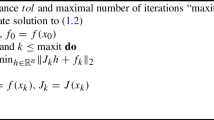Abstract
We consider a subproblem in parameter estimation using the Gauss-Newton algorithm with regularization for NURBS curve fitting. The NURBS curve is fitted to a set of data points in least-squares sense, where the sum of squared orthogonal distances is minimized. Control-points and weights are estimated. The knot-vector and the degree of the NURBS curve are kept constant. In the Gauss-Newton algorithm, a search direction is obtained from a linear overdetermined system with a Jacobian and a residual vector. Because of the properties of our problem, the Jacobian has a particular sparse structure which is suitable for performing a splitting of variables. We are handling the computational problems and report the obtained accuracy using different methods, and the elapsed real computational time. The splitting of variables is a two times faster method than using plain normal equations.




Similar content being viewed by others
References
Ahn, S.J.: Geometric fitting of parametric curves and surfaces. JIPS 4(4), 153–158 (2008)
Atieg, A., Watson, G.A.: A class of methods for fitting a curve or surface to data by minimizing the sum of squares of orthogonal distances. J. Comput. Appl. Math. 158(2), 277–296 (2003)
Björck, Å.: Numerical Methods for Least Squares Problems. SIAM, Philadelphia (1996)
Boggs, P.T., Donaldson, J.R., Byrd, R.h., Schnabel, R.B.: Algorithm 676: Odrpack: software for weighted orthogonal distance regression. ACM Trans. Math. Softw. 15, 348–364 (1989)
Borges, C.F.: A full-Newton approach to separable nonlinear least squares. Electron. Trans. Numer. Anal. 35, 57–68 (2009)
Borges, C.F., Pastva, T.: Total least squares fitting of Bézier and B-spline curves to ordered data. Comput. Aided Geom. Des. 19(4), 275–289 (2002)
Carlson, N., Gulliksson, M.: Surface fitting with NURBS: a Gauss-Newton with trust region approach. In: MATH’08: Proceedings of the 13th WSEAS International Conference on Applied Mathematics, pp. 169–174. World Scientific and Engineering Academy and Society (WSEAS), Stevens Point, (2008)
Cox, M.: The least-squares solution of linear equations with block-angular observation matrix. In: Cox, M., Hammarling, S. (eds.) Reliable Numerical Computation. Oxford University Press, Oxford (1990)
Dan, J., Lancheng, W.: An algorithm of NURBS surface fitting for reverse engineering. Int. J. Adv. Manuf. Technol. 31, 92–97 (2006)
Gilbert, J.R., Moler, C., Schreiber, R.: Sparse matrices in Matlab: design and implementation. SIAM J. Matrix Anal. Appl. 13, 333–356 (1992)
Householder, A.S.: Unitary triangularization of a nonsymmetric matrix. J. ACM 5, 339–342 (1958)
Laurent-Gengoux, P., Mekhilef, M.: Optimization of a NURBS representation. Comput. Aided Des. 25(11), 699–710 (1993)
Ma, W., Kruth, J.P.: Parameterization of randomly measured points for least squares fitting of B-spline curves and surfaces. Comput. Aided Des. 27(9), 663–675 (1995)
Ma, W., Kruth, J.P.: NURBS curve and surface fitting for reverse engineering. Int. J. Adv. Manuf. Technol. 14(12), 918–927 (1998)
Mizutani, E., Demmel, J.W.: On structure-exploiting trust-region regularized nonlinear least squares algorithms for neural-network learning. Neural Netw. 16(5–6), 745–753 (2003)
Piegl, L., Tiller, W.: The NURBS Book, 2nd edn. Springer, New York (1997)
Piegl, L.A., Tiller, W.: Parametrization for surface fitting in reverse engineering. Comput. Aided Des. 33(8), 593–603 (2001)
Sourlier, D.M.: Three dimensional feature independent bestfit in coordinate metrology. Ph.D. thesis, ETH, Zürich (1995). doi:10.3929/ethz-a-001516147
Speer, T., Kuppe, M., Hoschek, J.: Global reparametrization for curve approximation. Comput. Aided Geom. Des. 15(9), 869–877 (1998)
Turner, D., Anderson, I., Mason, J., Cox, M., Forbes, A.: An efficient separation-of-variables approach to parametric orthogonal distance regression. In: Ciarlini, P., Forbes, A., Pavese, F., Richter, D. (eds.) Advanced Mathematical and Computational Tools in Metrology IV. Series on Advances in Mathematics for Applied Sciences, vol. 53, pp. 246–255. World Scientific, Singapore (2000)
Wang, W., Pottmann, H., Liu, Y.: Fitting B-spline curves to point clouds by curvature-based squared distance minimization. ACM Trans. Graph. 25(2), 214–238 (2006)
Yang, L., Wenping, W.: A revisit to least squares orthogonal distance fitting of parametric curves and surfaces. Adv. Geom. Modeling Process. 4975(5), 384–397 (2008)
Author information
Authors and Affiliations
Corresponding author
Additional information
Communicated by Tom Lyche.
Appendix
Appendix
In this appendix we are giving some details about the origin of G, g and (3.9). The rows in \(\tilde{\mathbf{J}}\) consisting of \(\lambda_{u_{k}}\) and c′ k is here denoted \([\bar{\boldsymbol{\mathcal{L}}}_{k} \ \bar{\boldsymbol{\mathcal{S}}}_{k}]\), and the corresponding rows in \(\tilde{\mathbf{r}}\) is denoted \(\bar{\mathbf{r}}_{k}\). The parameter \(\lambda_{u_{k}}\) is in the first row of \(\bar{\boldsymbol{\mathcal{L}}}_{k}\). Explicitly written, we have

and from these quantities we form the matrices
which are same as \(\tilde{\mathbf{J}}\) and \(\tilde{\mathbf{r}}\), but with interchanged rows.
We use an orthogonal matrix similar to a Householder transformation [11],
where
It gives that \(\| \mathbf{v}_{k} \| _{2}^{2}=2(\sigma_{k}+\lambda _{u_{k}}\sqrt{\sigma_{k}})\). Usually the opposite sign of Φ k is used, making it to a reflection matrix. We could have done that but our way makes subsequent expressions simpler without minus signs. We multiply \(\bar{\boldsymbol{\mathcal{L}}}_{k}\), \(\bar{\boldsymbol{\mathcal{S}}}_{k}\) and \(\bar{\mathbf{r}}_{k}\) with Φ k . That results in
where

Let
be a diagonal matrix, and let
be a block diagonal matrix. Note that Z 2=D. The matrix B is an orthogonal matrix since all of its diagonal blocks are orthogonal. The vector \(\bar{\mathbf{J}}\boldsymbol{\delta}+ \bar{\mathbf{r}}\) is a row interchanged version of the vector \(\tilde{\mathbf{J}}\boldsymbol{\delta} + \tilde {\mathbf{r}}\), and B is an orthogonal matrix, so
Using (8.1) and doing relevant row interchanges in the last expression, which does not affect the norm, we get
where
and where Λ s,i is the regularization parameters for (p i ,w i ). Finding the least-squares solution is done by solving (3.9). By forming the normal equations, we get the same expression as in (3.5) and (3.6), since A=G T G and b=−G T g.
Rights and permissions
About this article
Cite this article
Bergström, P., Edlund, O. & Söderkvist, I. Efficient computation of the Gauss-Newton direction when fitting NURBS using ODR. Bit Numer Math 52, 571–588 (2012). https://doi.org/10.1007/s10543-012-0371-7
Received:
Accepted:
Published:
Issue Date:
DOI: https://doi.org/10.1007/s10543-012-0371-7
Keywords
- Block angular form
- Gauss-Newton
- Jacobian
- Least-squares
- Levenberg-Marquardt
- NURBS fitting
- Orthogonal distance regression




